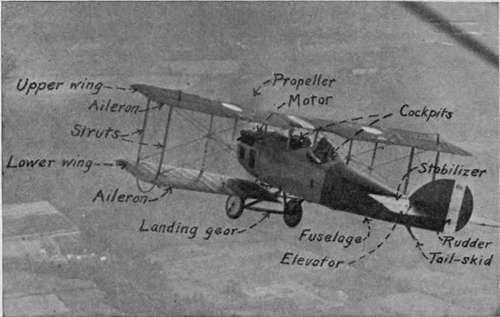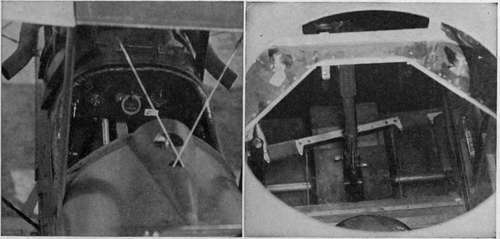Construction Of The Airplane
Description
This section is from the book "Airplane Photography", by Herbert E. Ives. Also available from Amazon: Airplane photography.
Construction Of The Airplane
The modern airplane (Fig. 1) consists of one or more planes, much longer across than in the direction of flight {aspect ratio). These are inclined slightly upward toward the direction of travel, and their rapid motion through the air, due to the pull of the propeller driven by the motor, causes them to rise from the earth, carrying the fuselage or body of the airplane. In the fuselage are carried the pilot, observer, and any other load. Wheels below the fuselage forming the under-carriage or landing gear serve to support the body when running along the ground in taking off or landing. The pilot, sitting in one of the cockpits, has in front of him the controls, by means of which the motion of the plane is guided (Figs. 2 and 3). These consist of the engine controls—the contacts for the ignition, the throttle, the oil and gasoline supply, air pressure, etc., and the steering controls—the rudder bar, the stick and the stabilizer control. The rudder bar, operated by the feet, controls both the rudder of the plane, which turns the plane to right or left in the air, and the tail skid, for steering on the ground. The stick is a vertical column in front of the pilot which, when pushed forward.or back, depresses or raises the elevator and makes the machine dive or climb. Thrown to either side it operates the ailerons or wing tips, which cause the plane to roll about its fore and aft axis. The stabilizer control is usually a wheel at the side of the cockpit, whose turning varies the angle of incidence of the small stabilizing plane in front of the elevator, to correct the balance of the plane under different conditions of loading.

Fig. 1. - The elements of the plane.
The fuselage consists usually of a light hollow framework of spruce or ash, divided into a series of bays or compartments by upright members, connecting the longerons, which are the four corner members, running fore and aft, of the plane. Diagonally across the sides and faces of these bays are stretched taut piano wires, and the whole structure is covered with canvas or linen frabic. Cross-wires and fabric are omitted from the top of one or more bays to permit their being used as cockpits for pilot and observer. In later designs of planes the wire and fabric construction has been superseded by ply-wood veneer, thereby strengthening the fuselage so that many of the diagonal bracing wires on the inside are dispensed with. This greatly increases the accessibility of the spaces in which cameras and other apparatus must be carried.

Fig. 2. - Forward cockpit of DeHaviland 4, showing instrument board. Fig. 3. - Rear cockpit of DeHaviland 4, showing rear "stick" and rudder bar.
The fuselage differs greatly in cross-section shape and in roominess according to the type of engine. In the majority of English and American planes, with their vertical cylinder or V type engines, the fuselage is narrow and rectangular in cross-section. In many French planes, radial or rotary engines are used and the fuselage is correspondingly almost circular, and so is much more spacious than the English and American planes of similar power. The shape and size of the plane body has an important bearing on the question of camera installation.
Continue to:
- prev: Chapter II. The Airplane Considered As A Camera Platform
- Table of Contents
- next: Types Of Planes
Tags
camera, lens, airplane, aerial, film, exposure, photography, maps, birdseye
